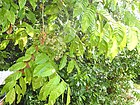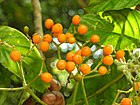Note: This is a project under development. The articles on this wiki are just being initiated and broadly incomplete. You can Help creating new pages.
Difference between revisions of "Micromelum integerrimum"
| Line 2: | Line 2: | ||
'''Micromelum integerrimum''' are several subfamilies in the citrus family, with genus Citrus classified in the Aurantioideae. Micromelum belongs to the other tribe in this subfamily, Clauseneae. It is the only genus of the subtribe Micromelinae, which are known technically as the very remote citroid fruit trees. | '''Micromelum integerrimum''' are several subfamilies in the citrus family, with genus Citrus classified in the Aurantioideae. Micromelum belongs to the other tribe in this subfamily, Clauseneae. It is the only genus of the subtribe Micromelinae, which are known technically as the very remote citroid fruit trees. | ||
==Uses== | ==Uses== | ||
| − | {{Uses| | + | {{Uses|Fever}}, {{Uses|Ringworm}}, {{Uses|Dysentery}}, {{Uses|Arthritis}}. |
==Parts Used== | ==Parts Used== | ||
| Line 34: | Line 34: | ||
==Identification== | ==Identification== | ||
===Leaf=== | ===Leaf=== | ||
| − | {{Leaf|Aromatic|Alternately arranged|They are usually pinnate, divided into up to 23 leaflets, except for M. diversifolium, which sometimes has undivided leaf blades | + | {{Leaf|Aromatic|Alternately arranged|They are usually pinnate, divided into up to 23 leaflets, except for M. diversifolium, which sometimes has undivided leaf blades.}}<ref name="Leaf"/> |
===Flower=== | ===Flower=== | ||
| − | {{Flower|Unisexual|5-10 mm| | + | {{Flower|Unisexual|5-10 mm|Green, white, or yellow||Outside densely velvet-hairy. Disk is columnar, stigma head-like.}} |
===Fruit=== | ===Fruit=== | ||
| − | {{Fruit| | + | {{Fruit|Ellipsoid to obovoid|1-1.5 x 0.6-1.2 cm||Crimson red|Fruit is of the size of a cherry, turbinate, smooth, when ripe, succulent.}} |
===Other features=== | ===Other features=== | ||
| Line 51: | Line 51: | ||
==How to plant/cultivate== | ==How to plant/cultivate== | ||
| − | There are quite a number these plants at this place but all are small (say 10-12 ft high). Literature says Trichilia connaroides grows up to 10 meters. | + | There are quite a number these plants at this place but all are small (say 10-12 ft high). Literature says Trichilia connaroides grows up to 10 meters. <ref name="How to plant/cultivate"/> |
| − | <ref name="How to plant/cultivate"/> | ||
==Commonly seen growing in areas== | ==Commonly seen growing in areas== | ||
| Line 66: | Line 65: | ||
==References== | ==References== | ||
<references> | <references> | ||
| − | <ref name="chemical composition">[https://journals.sagepub.com/doi/full/10.1177/1934578X20927124 | + | <ref name="chemical composition">[https://journals.sagepub.com/doi/full/10.1177/1934578X20927124 Sciencedirect]</ref> |
| − | <ref name="Leaf">[https://www.flowersofindia.net/catalog/slides/Entire-Leaf%20Lime%20Berry.html | + | <ref name="Leaf">[https://www.flowersofindia.net/catalog/slides/Entire-Leaf%20Lime%20Berry.html Wayback machine]</ref> |
| − | <ref name="How to plant/cultivate">[https://sites.google.com/site/efloraofindia/species/m---z/r/rutaceae/micromelum/micromelum-pubescens | + | <ref name="How to plant/cultivate">[https://sites.google.com/site/efloraofindia/species/m---z/r/rutaceae/micromelum/micromelum-pubescens Cultivation]</ref> |
</references> | </references> | ||
==External Links== | ==External Links== | ||
| − | * [https://web.archive.org/web/20110719055159/http://websites.lib.ucr.edu/agnic/webber/Vol1/Chapter3.html Micromelum integerrimum] | + | * [https://web.archive.org/web/20110719055159/http://websites.lib.ucr.edu/agnic/webber/Vol1/Chapter3.html Micromelum integerrimum on web.archive.org] |
[[Category:Herbs]] | [[Category:Herbs]] | ||
[[Category:Rutaceae]] | [[Category:Rutaceae]] | ||
Latest revision as of 17:59, 23 June 2020
Micromelum integerrimum are several subfamilies in the citrus family, with genus Citrus classified in the Aurantioideae. Micromelum belongs to the other tribe in this subfamily, Clauseneae. It is the only genus of the subtribe Micromelinae, which are known technically as the very remote citroid fruit trees.
Contents
- 1 Uses
- 2 Parts Used
- 3 Chemical Composition
- 4 Common names
- 5 Properties
- 6 Habit
- 7 Identification
- 8 List of Ayurvedic medicine in which the herb is used
- 9 Where to get the saplings
- 10 Mode of Propagation
- 11 How to plant/cultivate
- 12 Commonly seen growing in areas
- 13 Photo Gallery
- 14 References
- 15 External Links
Uses
Fever, Ringworm, Dysentery, Arthritis.
Parts Used
Chemical Composition
Phytochemically, many bioactive compounds, including coumarins, polyoxygenated flavonoids, phenylpropanoic acid derivatives, quinolone alkaloids, and also carbazole alkaloids, have been reported as secondary metabolites of the Micromelum spp. including many new compounds. [1]
Common names
| Language | Common name |
|---|---|
| Kannada | |
| Hindi | |
| Malayalam | |
| Tamil | |
| Telugu | |
| Marathi | NA |
| Gujarathi | NA |
| Punjabi | NA |
| Kashmiri | NA |
| Sanskrit | |
| English | Entire-Leaf Lime Berry |
Properties
Reference: Dravya - Substance, Rasa - Taste, Guna - Qualities, Veerya - Potency, Vipaka - Post-digesion effect, Karma - Pharmacological activity, Prabhava - Therepeutics.
Dravya
Rasa
Guna
Veerya
Vipaka
Karma
Prabhava
Habit
Identification
Leaf
| Kind | Shape | Feature |
|---|---|---|
| Aromatic | Alternately arranged | They are usually pinnate, divided into up to 23 leaflets, except for M. diversifolium, which sometimes has undivided leaf blades. |
Flower
| Type | Size | Color and composition | Stamen | More information |
|---|---|---|---|---|
| Unisexual | 5-10 mm | Green, white, or yellow | Outside densely velvet-hairy. Disk is columnar, stigma head-like. |
Fruit
| Type | Size | Mass | Appearance | Seeds | More information |
|---|---|---|---|---|---|
| Ellipsoid to obovoid | 1-1.5 x 0.6-1.2 cm | Crimson red | Fruit is of the size of a cherry, turbinate, smooth, when ripe, succulent. | {{{6}}} |
Other features
List of Ayurvedic medicine in which the herb is used
Where to get the saplings
Mode of Propagation
How to plant/cultivate
There are quite a number these plants at this place but all are small (say 10-12 ft high). Literature says Trichilia connaroides grows up to 10 meters. [3]
Commonly seen growing in areas
Photo Gallery
References
External Links
- Ayurvedic Herbs known to be helpful to treat Fever
- Ayurvedic Herbs known to be helpful to treat Ringworm
- Ayurvedic Herbs known to be helpful to treat Dysentery
- Ayurvedic Herbs known to be helpful to treat Arthritis
- Herbs with Leaves used in medicine
- Herbs with Flower used in medicine
- Herbs with common name in English
- Habit - Tree
- Index of Plants which can be propagated by Seeds
- Herbs that are commonly seen in the region of Tropical forest
- Herbs
- Rutaceae



